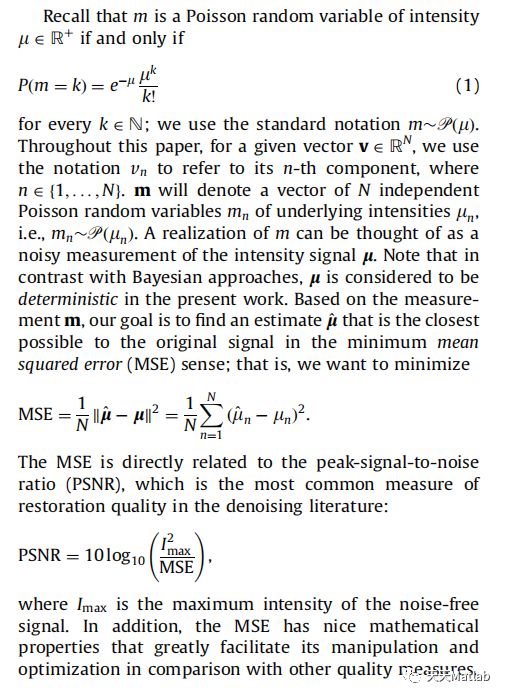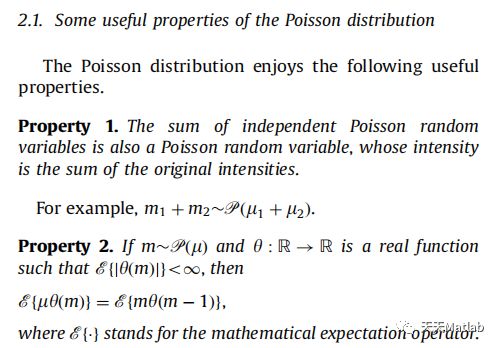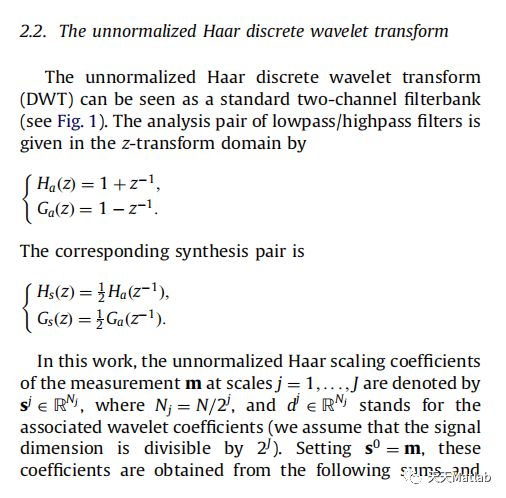【图像去噪】基于快速跨尺度小波降噪实现泊松损坏图像去噪处理附matlab代码
1 简介
‘‘Additive white Gaussian noise’’ is a ubiquitous model in the context of statistical image restoration. In many applications, however, the current trend towards quanti tative imaging calls for less generic models that better account for the physical acquisition process. The need for such models is particularly stringent in biomicroscopy, where live samples are often observed at very low light levels, due to acquisition-time and phototoxicity constraints. In this regime, the performance of the imaging device is typically shot-noise limited, i.e., the measure ment noise is strongly signal dependent. Thus, opting for a non-additive, non-Gaussian model can yield signifificant restoration-quality improvements in such applications. In this paper we present a novel algorithmic solution for denoising low-count images. Motivated by practical applications in biomedical imaging, we aim at a tractable
compromise between restoration quality, computational complexity and automation. Specififically, our goals are the following. First, we want a method that is designed for Poissonian noise, which is the most common model for low-intensity imaging. Second, the method should satisfy strict constraints in terms of computational cost and
memory requirements, so as to be able to process large data sets. Finally, we want the algorithm to require as less
user input as possible in order to facilitate its application
and to enhance the reproducibility of its results.
2 部分代码
% ------------------------------------------------------------------------% Function: PURELET for Poisson image denoising with cycle spinning% ------------------------------------------------------------------------% Usage 1: XHAT = CSPIN_PURELET( X, LET_ID, J, nSpin )%% Input parameters:% X = Poisson noisy input image% LET_ID = LET ID; should be 0, 1, or 2. See [1].% J = No. of Haar wavelet scales.% nSpin = No. of shifts. The first one is [0 0] by default. Remaining% nSpin-1 shifts are randomly computed using rand function.%% Output parameters:% XHAT = Estimated image%% Description: Denoises a Poisson-count noisy image using PURELET with% cycle spinning% ------------------------------------------------------------------------% References:% [1] F. Luisier, C. Vonesch, T. Blu, M. Unser, "Fast Interscale Wavelet% Denoising of Poisson-corrupted Images", Signal Processing, vol. 90,% no. 2, pp. 415-427, February 2010.% ------------------------------------------------------------------------% Author: Sandeep Palakkal ([email protected])% Affiliation: Indian Institute of Technology Madras% Created on: Feb 11, 2011% Modified on: Mar 19, 2011% ------------------------------------------------------------------------function y = cspin_purelet( x, let_id, J, nSpin )[m n] = size( x );shifts = round( rand(nSpin-1,2).*repmat( [m n], nSpin-1, 1 ) );shifts = [0 0; shifts];y = zeros( m, n );for ii = 1:nSpiny1 = purelet( circshift( x, shifts(ii,:) ), let_id, J );y = y + circshift( y1, -shifts(ii,:) );endy = y/nSpin;
3 仿真结果
4 参考文献
[1] Luisier F , Vonesch C , Blu T , et al. Fast interscale wavelet denoising of Poisson-corrupted images[J]. Signal Processing, 2010, 90(2):415-427.
博主简介:擅长智能优化算法、神经网络预测、信号处理、元胞自动机、图像处理、路径规划、无人机等多种领域的Matlab仿真,相关matlab代码问题可私信交流。
部分理论引用网络文献,若有侵权联系博主删除。






